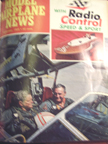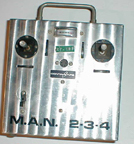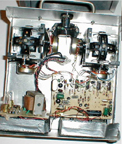September, 1968

Model Airplane News Cover for September, 1968
MAN 2-3-4 Proportional Radio Control System Click to Enlarge
Here is what the blurb about the cover has to say:
"... John Maloney, World Engines prexy at right, and Don Baisden, designer and creator of MAN's 2-3-4 Digital system, tested the system in plane and boat as shown in the cover photo. Prototype units received considerable flight testing in both machines. Inset photo shows the MAN 2-3-4 system in all its colorful good looks. Only two S3 servos are shown. The S4 servo is as small and powerful as any servo offered to date ..."
About the MAN 2-3-4 System


MAN 2-3-4 Kit Proportional Radio Control System
Click to Enlarge
The MAN 2-3-4 system is derived from the Controlaire proportional, jointly designed by Jack Port and Don Baisden in mid-1964.
- Jack Port developed a reliable single channel system which he dubbed “Controlaire”; he founded company of the same name and continued to run it after its merger with World Engines. He attained considerable stature in the world of model aviation when he won the 1953 Nationals.
- Don Baisden was a top engineer for North American Aviation who helped develop such famous full-scale aircraft as the C-5 Galaxy. He was also an avid modeler and inventor of the “Baisden Pulser” – an early pulse proportional system He was principally responsible for the encoder/decoder and Port for the RF section.
In December of 1964, World Engines had just completed its 1965 catalog. At the last minute, they added some updates on their proportional project. (All manufacturers were under great pressure to produce a proportional system or at least show progress.) In order to “show something” they published pictures of the first prototype. They said it was impossible to be sure when the system would be ready. In addition to having control sticks which were industrial works of art, the first Controlaire proportionals sported beautiful, hand-crafted trim and auxiliary levers. The desire to have the best quality regardless of cost was rampant. For example, Baisden was enamored of silicone controlled switches (SCS), enabling reliable receiver function in a compact single-deck configuration. They were employed in initial production units despite their staggering cost – over 6,200 percent higher than the standard transistors used later.
In early 1965 Controlaire completed its first production run of 50 units and prepared for brisk sales. Everyone there believed they had the finest system available both inside and out. Flight testing confirmed the Controlaire Proportional performed as good as it looked. Port and Baisden were so proud of their accomplishment that they “signed” their names into the circuit boards of the initial transmitters. Here’s how these unique autographed models looked:
Shortly after the first sales the complaints began. Airplanes were crashing due to episodic loss of control. Pilots were angry and Controlaire’s sterling reputation for quality and reliability was tarnished. All advertising and sales were halted for over a year until the problem could be solved and the solution verified. Jack Port had a heart attack and had to be hospitalized. Seven weeks later he had a second massive attack and did not survive. Model aviation lost one of its greats and Controlaire was thrown into disarray. Don Baisden gave up working on the C-5 Galaxy and moved to Cincinnati to take over as head of the Controlaire division. Finally one of the technicians accidentally discovered the problem while viewing a monitor. By holding the transmitter at certain angles and distances the receiver (on its own) would direct full hard-over controls without touching the transmitter’s sticks. This happened because, on some transmitters, the oscillator signal leaked through the buffer and filled in the “off” portions of the signal.
Success soon returned to Controlaire. Although sales of the reformed system were slow at first, they picked up. Controlaire briefly considered introducing a budget 3 channel rig (see Controlaire Three Channel) but decided instead to do the M.A.N. 2-3-4. This was a substantially redesigned and updated Controlaire proportional offering 4 channels of control in an affordable kit format. Its introduction was teamed with a series of monthly construction articles by Don Baisden in Model Airplane News. These enabled even electronics “dummies” to build their own modern proportional system by simply following Baisden’s step-by-step recipe “like baking a cake”.
The M.A.N. 2-3-4 was an attempt to repeat the success of the D.I.Y. “Digitrio” in Radio Control Modeler.. The Digitrio proportional kit was offered with a similar series of articles in RCM. So many sold that it was considered to be a great success for the magazine and for Digitrio kit producers like World Engines. The Digitrio phenomenon was a tough act to follow, but Controlaire managed nicely. The M.A.N. 2-3-4 was a homerun for Controlaire scoring huge sales and commercial success.
You may download the articles that appeared in MAN by using the following links:
- Part One Overview ( August, 1968)
- Part Two Assembly and Soldering ( September, 1968)
- Part Three The Decoder ( October, 1968)
- Part Four The Receiver ( November, 1968)
- Part Five Operational Notes and Summary ( January, 1969)

Click to go back and select another cover.
Counter for the Entire Site (not just this page..)
Home | About Lindy | Last Week's Reviews | Upcoming Events | 1940s Collecibles
The Guide - Establishments - Travel - Accessories
Music | Links | Photo Gallery | Extras | Contact